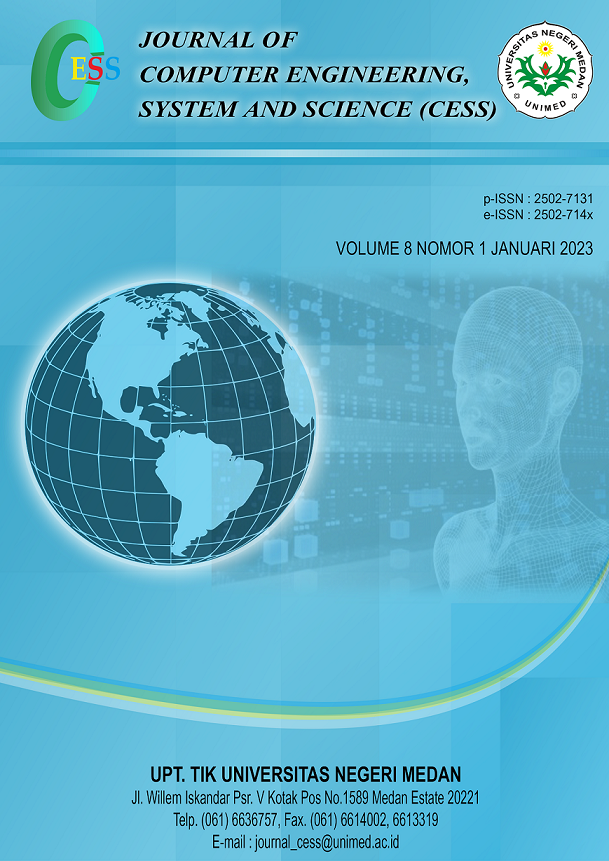Aeroponic Media Potato Plant Monitoring and Control System Internet of Things Based
DOI:
https://doi.org/10.24114/cess.v8i1.42432Keywords:
Aeroponics, Internet of Things, Nutrient, Spraying, WebsiteAbstract
Aeroponics is a farming method without soil media that works by spraying water and a nutrient solution in the form of a mist on plant roots. The use of the aeroponic method itself requires monitoring and controlling air temperature, air humidity, water temperature, and nutrient levels. Incorrect settings can cause plants to experience drought, root rot, and a lack of nutritional elements, which can cause plant death. Therefore, we need a system that can monitor and control air temperature, air humidity, water temperature, and nutrient content. This research builds an Internet of Things-based system that can assist in providing information regarding the values of air temperature, air humidity, water temperature, and nutrient content displayed on the website application. The system can also perform manual and automatic control functions. In the test results, the sensor value reading system has an accuracy of 98.56% for air temperature, 96.89% for accuracy of air humidity readings, 99.64% for accuracy of water temperature readings, 97.02% for accuracy of nutrient solution readings, and 99.86% for accuracy of water level readings. The test results from observing potato plants for 21 days showed an increase in growth in the highest plant height with an average of 4.36 cm and the lowest plant height growth with an average of 0.96 cm.References
G. K. Dewi and N. Syamsiyah, œAlih Fungsi Lahan Sawah Dan Pengaruhnya Terhadap Pendapatan Petani Di Desa Cacaban, Kecamatan Conggeang, Kabupaten Sumedang, Mimb. Agribisnis J. Pemikir. Masy. Ilm. Berwawasan Agribisnis, vol. 6, no. 2, p. 843, 2020, doi: 10.25157/ma.v6i2.3572.
V. I. Safitri, œDeteksi Penyakit Tanaman Kentang Menggunakan Metode Certainty Factor, JATI (Jurnal Mhs. Tek. Inform., vol. 1, no. 1, pp. 798“805, 2017.
P. Hidayah, M. Izzati, and S. Parman, œPertumbuhan dan Produksi Tanaman Kentang (Solanum tuberosum L. var. Granola) pada Sistem Budidaya yang Berbeda, Bul. Anat. dan Fisiol., vol. 2, no. 2, p. 218, 2017, doi: 10.14710/baf.2.2.2017.218-225.
I. A. Sari, A. N. Handayani, and D. Lestari, œSmart Greenhouse sebagai Media Pembibitan Kentang Granola Kembang Berbasis Mikrokontroler, Pros. Semin. Nas. Teknol. Elektro Terap., vol. 02, no. 01, pp. 105“110, 2018, [Online]. Available: https://prosiding.polinema.ac.id/sngbr/index.php/sntet/article/view/155.
Wulandari and N. W. Sumiar, œPengembangan Sistem Pengaturan Larutan Nutrisi Otomatis Pada Budidaya Kentang Aeroponik, J. Ilmu Komput. dan Agri-Informatika, vol. 8, no. 1, pp. 57“68, 2021, doi: 10.29244/jika.8.1.57-68.
Susilawati, Dasar “ Dasar Bertanam Secara Hidroponik. 2019.
endang dwi Purbajanti, W. Slamet, and F. Kusmiyati, Hydroponic Bertanam tanpa tanah, 1st ed. Semarang: EF Press Digimedia, 2017.
B. P. C. Bareta, A. Harijanto, and M. Maryani, œRancang Bangun Alat Ukur Sistem Monitoring pH, Temperatur, Dan Kelembapan Akuarium Ikan Hias Berbasis Arduino Uno, J. Pembelajaran Fis., vol. 10, no. 1, p. 1, 2021, doi: 10.19184/jpf.v10i1.21900.
Solihin, D. Triyanto, and U. Ristian, œSistem Monitoring pH Air Dan Kontrol Pompa Air Untuk Persiapan Penyiraman Tanaman Berbasis Internet of Things (Studi Kasus: SMART GARDEN FMIPA UNTAN), Coding J. Komput. dan Apl., vol. 09, no. 02, pp. 239“249, 2021.
A. W. Wicaksono, E. R. Widasari, and F. Utaminingrum, œImplementasi Sistem Kontrol dan Monitoring pH pada Tanaman Kentang Aeroponik secara Wireless, J. Pengemb. Teknol. Inf. dan Ilmu Komput., vol. 1, no. 5, pp. 386“398, 2017.
P. D. I. I. R. Sastrahidayat, Tanaman Kentang dan Pengendali Hama Penyakitnya, 1st ed. Malang: Tim UB Press, 2011.
U. Yulianti and Yefriwati, œPengaruh Jarak Tanaman Terhadap Pertumbuhan Umbi Tanaman Kentang (Solanum tuberosum.L) di Balai Pengkajian Teknologi Pertanian Sumatera Barat, vol. 1, no. 2, pp. 40“47, 2020.
F. El Khair and R. Ferdian, œRancang Bangun Sistem Kontrol Pertumbuhan Sayuran di Dalam Ruangan dengan Metode Tanam Aeroponik, Chipset, vol. 1, no. 1, pp. 5“9, 2020.
S. Mluyati and S. Sadi, œINTERNET OF THINGS (IoT) PADA PROTOTIPE PENDETEKSI KEBOCORAN GAS BERBASIS MQ-2 dan SIM800L, J. Tek., vol. 7, no. 2, 2019, doi: 10.31000/jt.v7i2.1358.
M. F. Wicaksono, œImplementasi Modul Wifi NODEMCU ESP8266 Untuk Smart Home, J. Tek. Komput. Unikom, vol. 6, no. 1, 2017, doi: 10.33751/komputasi.v16i2.1622.
N. C. Putra, Jayanta, and Y. Widiastiwi, œPenerapan Logika Fuzzy Untuk Mendeteksi Kualiatas Air Higiene Sanitasi Menggunakan Metode Sugeno ( Studi Kasus : Air Tanah Kota Bekasi ), J. Semin. Nas. Mhs. Ilmu Komput. dan Apl., vol. 1, no. 4, pp. 693“706, 2020.
M. T. Sulistyo, œSistem Pengukuran Kadar Ph , Suhu , Dan Sensor Turbidity Pada Limbah Rumah Sakit Berbasis Arduino UNO, pp. 1“10, 2019.
E. Nurazizah, R. Mohamad, and R. Achmad, œRancang Bangun Termometer Digital Berbasis Sensor Ds18b20 Untuk Penyandang Tunanetra | Nurazizah | eProceedings of Engineering, vol. 4, no. 3, pp. 3294“3301, 2017, [Online]. Available: https://openlibrarypublications.telkomuniversity.ac.id/index.php/engineering/article/view/4858/4812.
A. F. Adella, M. F. P. Putra, F. Taufiqurrahman, and A. B. Kaswar, œSistem pintu cerdas menggunakan sensor ultrasonic berbasis internet of things, J. Media Elektr., vol. 17, no. 3, pp. 1“7, 2020.
Downloads
Published
Issue
Section
License
Copyright (c) 2023 CESS (Journal of Computer Engineering, System and Science)

This work is licensed under a Creative Commons Attribution 4.0 International License.










